Small vegetable gardens are a challenge, but this PVC tower garden can help you get the most out of your space! Make it from recycled PVC pipe and grow more than a dozen plants in a single square foot.
Need to stretch your gardening space? We’ve all heard about going vertical, but here’s another way to take your garden to new heights: A PVC tower garden.
New to gardening? Limited on space? The 5-Gallon Garden gives you the skills you need to grow food in the space you have. Get started with your garden today!
How to make a PVC tower garden
This simple vertical garden allows you to grow more than a dozen plants in one square foot of space by growing vertically.
I did this experimentally several years ago, planting basil and bok choy in my DIY garden tower. The basil got a bit leggy after several months, but I think that’s my fault for being a little lax in caring for the tower. The bok choy worked beautifully.
I used a salvaged piece of pvc to make the vertical garden tower and filled it with a good quality soil. *Yes, it’s plastic, but it was diverted from the landfill. I encourage you to seek out a source for used PVC — think county maintenance yards, construction sites, and road repair companies.
Grow Some Greens!
Ready to grow fresh greens, no matter WHERE you live? Sign up for my
FREE quick-start guide and start growing some of your own food!
Drilling the PVC for this tower garden requires a hole saw. This is a special bit that attaches to standard electric or cordless drills. After cutting each hole, you’ll find that the PVC remains stuck inside the hole saw. Sometimes you can wiggle it out with your fingers; sometimes you’ll need to take the bit off of the drill and tap the bit to knock the circle of plastic out.
Cutting these holes will generate little bits of plastic. I highly recommend working on a sheet of cardboard or a drop cloth so that you can collect all of the little bits and dispose of them.
The instructions below are very specific for people who like detailed directions. I have to be honest though. You don’t have to be really perfect about the placement of the holes as you’re making this PVC tower garden.
Planting out the grow tower
It can be a bit fiddly to plant each seedling into this PVC tower garden. The idea here is to use cardboard as a temporary method of holding the soil in place while each of the seedlings develop a root system. Without it, the soil will wash away every time you water. That said, it doesn’t have to be perfect.
I found that slightly folding each cardboard square and using it as a sort of funnel made it easy to set the seedling in place. Once the seedling has been pushed back into the hole, you’ll kind of pull and bend the piece of cardboard into place between the seedling and the hole. Just be careful not to smash the seedling as you maneuver it into place.
Related: Fail-Proof Food Crops for Beginners
What can you grow in this tower garden?
This setup is best used for small plants. I’ve had good luck growing various greens, like lettuce, bok choy, and kale, as well as herbs. This is also a good option for growing strawberries to keep them up off the ground out out of the path of marauding snails.
Is the PVC safe?
Is pvc safe to plant in for health reasons? I dunno. I don’t know if pvc will leach chemicals into the soil, or if the plants will uptake them if they do. Certainly, given the choice between a pvc garden tower to grow in or a large, flat piece of sunny slug-free space, I’d choose the sunny space. But until I have that, I’ll continue experimenting!
Related: Upside-Down Tomatoes: Using Your Vertical Space
Does this vertical garden tower work?
Yes! It worked when I first tried this, and I’ve just planted a new tower and filled it with lettuce. Since we battle slugs here with the year-round rain, planting in a vertical tower like this is another one of my attempts to grow slug-proof lettuce.
Don’t have time to build your PVC tower garden?
If you love the idea of a vertical garden, but just don’t have the time or inclination to build a grow tower of your own, there’s a ready-made option for you right here. It will take up a little bit more space, but it’s still a great way to get growing if you’re limited on garden space!
★ Did you make this PVC tower garden? Don’t forget to give it a star rating below! ★
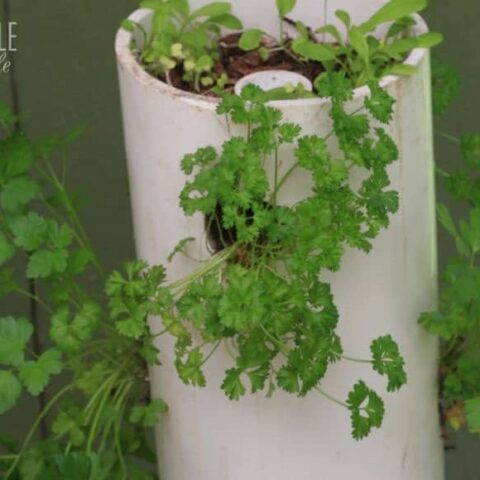
DIY Vertical Garden
This simple vertical planter allows you to grow more than a dozen plants in one square foot of space. It’s easy to make using materials from a building supply store, but if you know someone in the construction industry, you might be able to salvage what you need, as I did. The diameter of pipe for this project is a bit flexible, which allows you to choose what works best for you.
Materials
For making the tower
- PVC pipe – 6-to-8-inch diameter by 4 ft. long
- PVC pipe – 1½-to-2-inch diameter by 4 ft. long
For assembling the tower
- Potting soil
- 16 Pieces Recycled cardboard, roughly 2-inch square
- 17 Seedlings of lettuce and mixed greens
Tools
- Cordless or electric drill
- 1-1/2 inch Hole saw for drill
- ¼ inch Drill bit
- Pencil
- Tape measure
Instructions
- Mark four evenly spaced lines vertically down the large pipe. These will serve as guides for the holes you'll drill.
- Measure 12 inches from one end and mark a line around the circumference of the pipe. For reference, mark this end of the pipe "DOWN" so you'll remember that this end should go down into the soil when assembling your salad tower.
- Using the hole saw, drill one hole where a vertical line intersects with a horizontal line. Now drill a second hole directly opposite, again at the intersection of a vertical and horizontal line. (Mind you, these holes do not have to be perfectly aligned; just get them in the ballpark.)
- Drill three more holes along the same vertical lines, leaving about 10 inches between holes. You now have two lines of four drilled holes.
- Drill three holes on each of the remaining vertical lines, offsetting each new hole so that it's placed diagonally from those adjacent to it, making an alternating pattern.
- To use in the garden: Use shovel to dig a 10-inch deep hole in the ground and bury the bottom end of the pipe almost to the first hole.
- To use on a patio or balcony, drill several holes in the bottom of a 5-gallon bucket or large planter and fill halfway with gravel. Place the pipe on top of the gravel and add soil around the pipe, to the top of the container.
- Drill about 30 randomly-placed quarter-inch holes in the 2-inch PVC.
- Place small PVC pipe inside the larger PVC so that the top of the inner pipe is slightly higher than the outer pipe. (Add a bit of soil inside the 8-inch PVC to elevate the 2-inch pipe if necessary.) Once established, filling this inner pipe with water aids in getting moisture to the roots.
- Fill the large pipe with potting soil up to the bottom of the lowest holes, keeping the inner pipe centered.
- Fold a piece of cardboard into a V and set it inside the hole. Slide a seedling into each of the lowest holes, using the cardboard as a funnel of sorts. Gently push the piece of cardboard into the hole. This helps to prevent potting soil from escaping. Add more soil to reach the next set of holes. Lightly water seedlings in, to settle the soil. Continue in this manner until each hole is planted.
- Add a few more plants in the top of the tower.
- Water the tower slowly from the top as well as into the 2-inch pipe.
- Harvest leafy greens as they mature.
Notes
* This post layout has been updated, and the original star ratings lost. This project has 4.8 stars prior to the update!
Originally published in May, 2012.
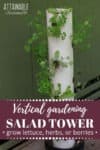
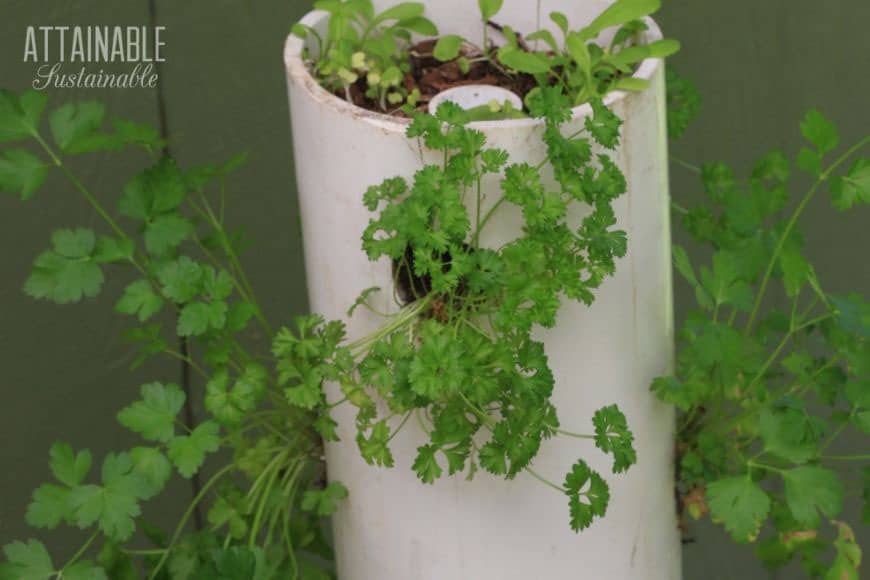

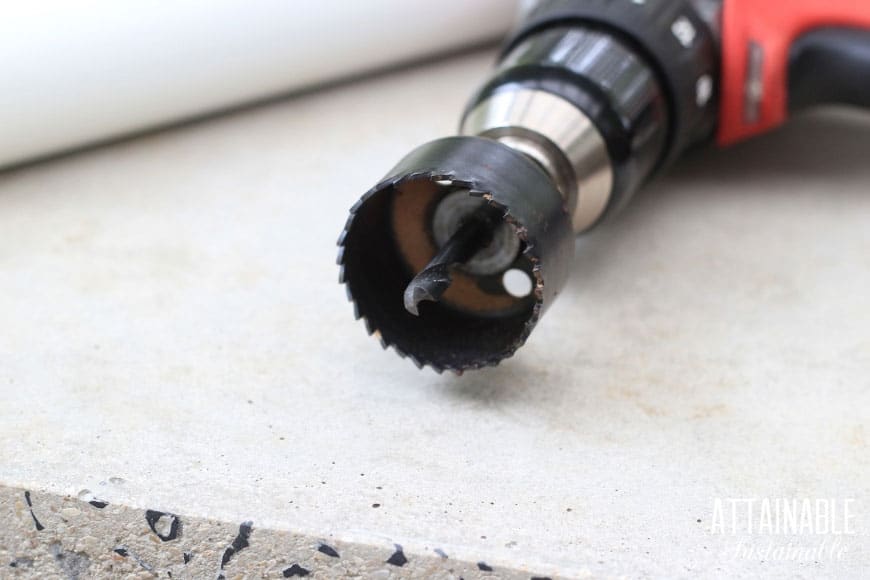
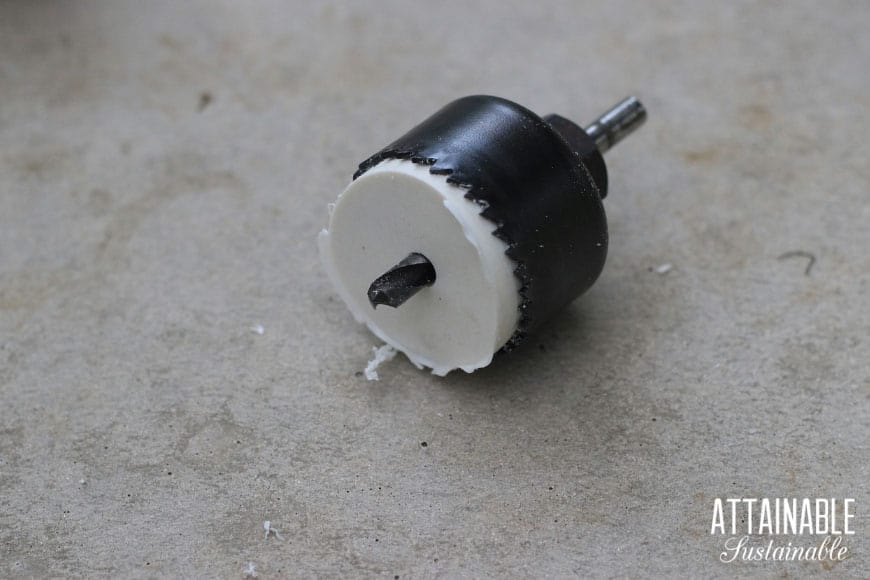
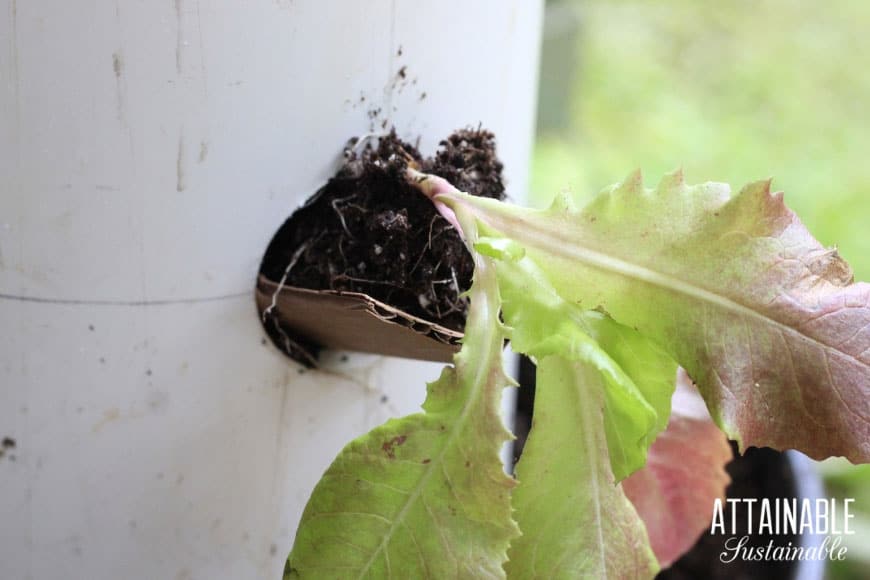
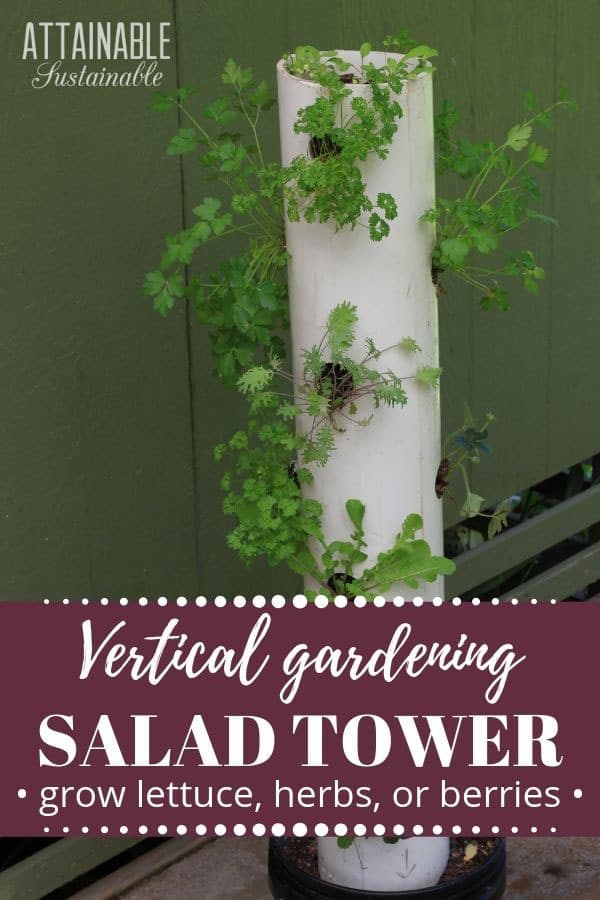
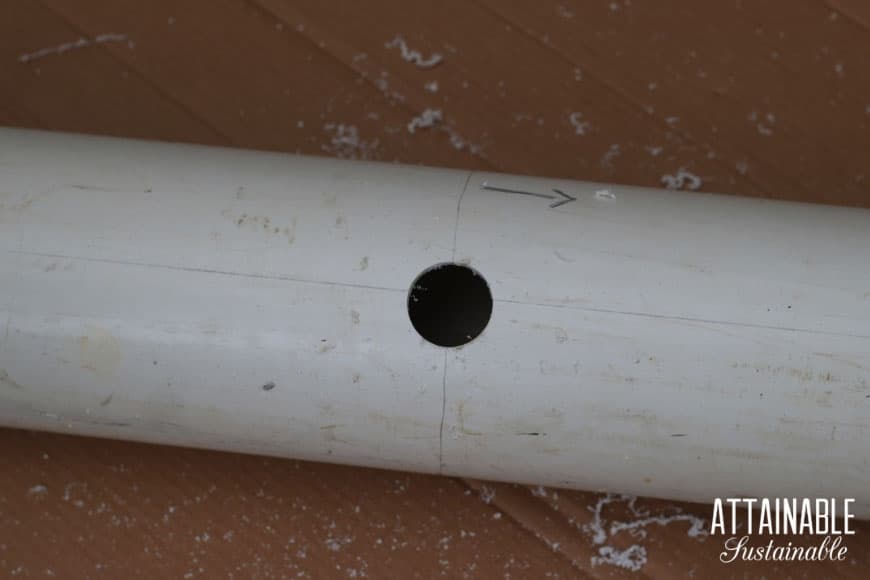
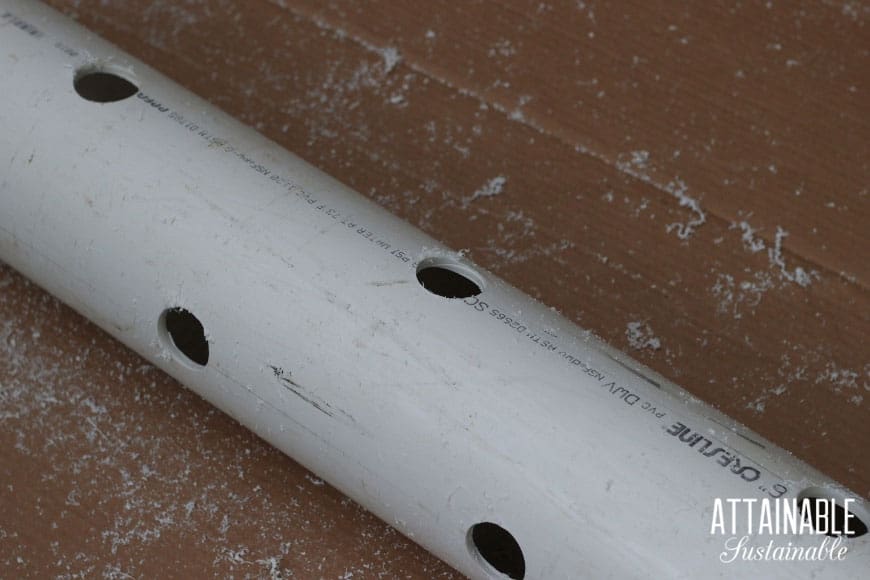
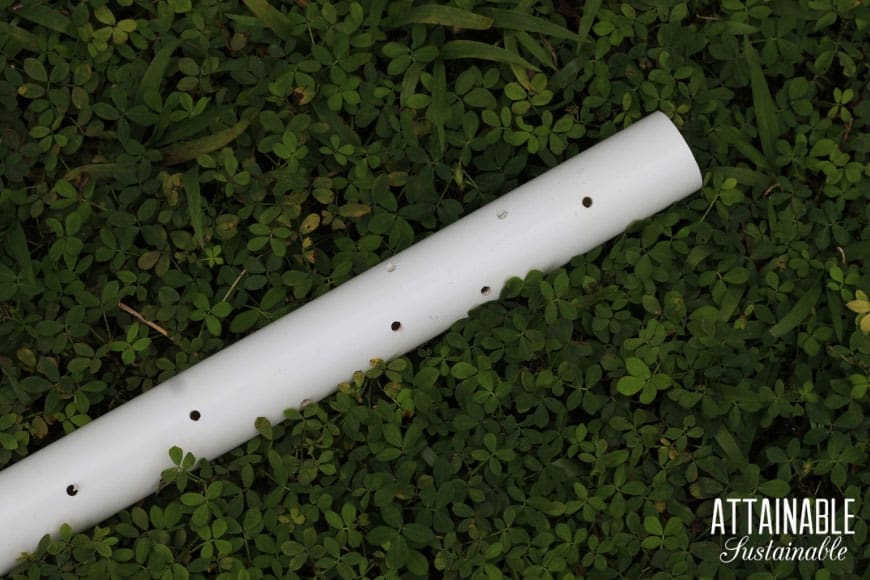
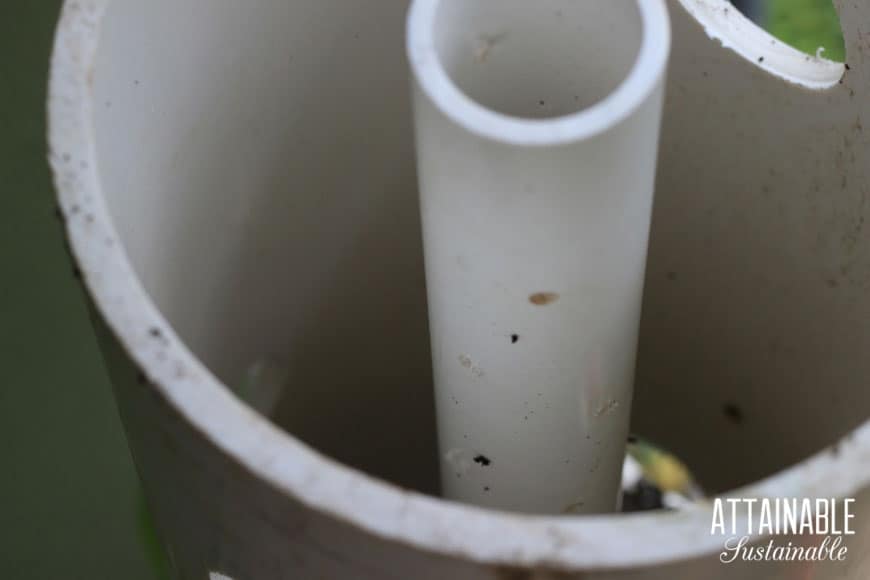
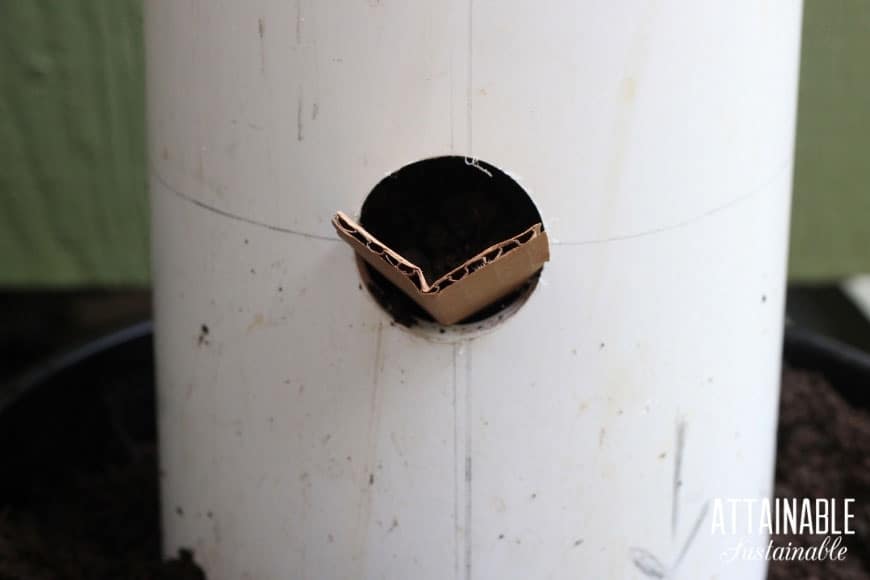





These plant suggestions are fantastic for small spaces! I love how this article provides a variety of plants that thrive in compact environments, from herbs and vegetables to ornamental plants. The tips on container gardening and vertical gardening are especially helpful for maximizing space. Thank you for sharing these ideas and inspiring us to bring greenery into even the tiniest of spaces!
I built one 3-4 years ago and it did not work for me because the soil settled down pulling the plants down inside . you need some way to prevent the soil from doing that. I have thought about putting some wire or something to hold the soil in place but have not tried it yet.
Is PVC food safe?
There’s been a lot of discussion about that here in the comments.
you probably have pvc water pipes in your house.
Would it work for garlic or onions? You could put a lot of garlic in one of these. Just wondering.
No. And I know that for certain because I tried it. 😉
Good idea pvc pipe cannot harm you
I can’t imagine using PVC would be any kind of health problem, after all it’s used for water piping.
great idear
I did this using a 5 foot length of 6 inch PVC. Instead of putting it in the ground, I put it in a 5 gallon bucket and filled both with gravel up to about 4 inches from the top of the bucket. Put a coffee filter on top of the gravel inside the pipe, to stop the soil from filtering down into the gravel. Filled with potting soil as per the instructions above. Also put potting soil in the top of the bucket. So far, I’ve only planted the bottom 6 holes with strawberries. Will get another variety of strawberries for the top 6 holes this week. Planted herbs in the bucket around the pipe. So far, so good.
Awesome! That’s exactly what I was thinking for a patio version (mounting it in a bucket).
An idea I just got was to use PEX on the inside of a 1″ ir 3/4 inch pvc with a perhapa a mess ( maybe even cheesecloth ).
Example: What we could do ( as an experiment ) is put ( the author suggested ) another PCV pipe 3/4 or 1″ ( with adequate Holes in it ) in the interior ( For irrigation ) following the entire lengh of the outer PVC and then add on the interior of that 3/4 inch or 1″ a PEX line ( Following the same lengh of the PVC ) with very small holes every few inches or so surrounded by cheesecloth or some other kind of mess )
WHY you may ask?
1: So it can be attached easily to faucet! And then this opens up a whole new set of possibilities.
IF you just want to help irrigation then you can just use the pex attached to a faucet and then open the faucet briefly just to water your plants.
2: All the lines can be connected together easily so this would save time watering your plant as this can be put onto a timer that would open the valve every so often on schedual.
3: A ferilizing system ( A Large plastic container ) connect to the water line just before the plants can be added so that your can put a single load of liquid fertilizer in the container that would auto fertilize all connected plants OR plants which use the same frequency and type or amount of fertilizer.
NOTE: You can easily just have more than one Fertilizing tank for differnent types of plants.
If you just want to water your plants without going as far as the above possibilities then you can just still use the suggestion 1: and use the PEX line with a simple Funnel ( Perchase it at a 1 dollar store ) and simply add water till is over flows and then stop and remove your funnel to let excess water spill out and then put away till next time watering..
IMPORTANT: This idea is just an idea, we would have to experiment on the holes size in the pex to make sure that just the right amount of water comes out. ( In order to not over water our plants )
I am thinking for test purposes starting of with a 1/16 drill bit and drilling two holes ( slighty offseted ) every 3-4 iches verticaly from top to bottom..
The other outer pvc ( The 3/4 or 1″ ) is to also help water dispersal but you would have to also make sure that it as well has as many holes as the PEX does. The PVC also acts as a container for the pex lines so that we can pull it out if we need to clean it or what not..
The reason of the cheese cloths is to help keep the holes clear so that water flows through from top to bottom.
What about the plants on the north side of the pipe? How do they get enough sun to flourish since they are mostly in the shade all day?
I’ve used it mostly for greens, which are tolerant of a little shade.
I am loving revisiting the tower idea. We are in the deep south (S FL) and in the hot months cannot grow much. Hubs has been seriously enjoying the fresh salad all winter and I was wondering how to make that work in the summer. I think using a similar method, I could grow salad in the shadiest part next to the house in the summer as long as it drained well. Gonna give it a try as he just retired as a plumber and I have a few HUGE runs of PVC taking up yard space and the tools to work with it handy 🙂
An easy way to move water down the middle is a cardboard tube from wrapping paper, filled with pea gravel or spagum moss. I do this in my strawberry pots, worked better than more pipe.
what a great idea!!!!!!
I hope it works well for you!
Do you have any suggestions for plants that do well being grown this way? I have about a 12 square foot area, but we usually grow as much as possible in it. Our biggest problem is running plants (cucumbers, squash, etc..) take over, and tomatoes shade too much of the space. Love this idea!
I’d stick with greens and herbs — lettuce, spinach, Swiss chard, bok choy. Basil did okay, but not great.
Great, thanks!
for your vining plants place a strong trellis to guide them onto. If fruits are heavy place each in a hammock made of an old nylon stocking. tie the nylon to the trellis. One year we placed cans of varied height under squash grown on a fence. worked great.
First I love your comment at the end of your post, I know why I love your blog so much is that your much like me, this may not be the best but for right now I have no better options, choices, whatever, and this will have to do. I really like this idea, and ideas form some of the commenters, wish I could actually see what they come up with, and since I’m working with limited funds with limited space this would be a great idea, but since I don’t have much space to start seedlings could I use seeds instead of plants, or would they have a tendency to grow upward.
I realize that you have limited space. I’ve started seeds indoors by using egg cartons. Transfer them to the tower when they get to large for container.
That would actually help to hold the tiny plants in place, too. Good idea!
I have done the pvc thing years ago and would not do it again. The plants get stressed = less berries, it takes more water than a mulched bed, the pill bugs constantly are mining out the soil which cause the plants to shift/drag/drop, don’t get any earth worm action up into the tower. It is the same problems but on a smaller scale than the vertical garden. What I do want to try is a chicken/hog wire bin of 3-4 ft/ 1 meter across and at same measurement in height with lots of active compost in center to do inter-cropping and perhaps place strawberries in this experiment. The compost would maybe attack too many berry loving bugs?
I was wondering if you could use larger PVC pipe to plant something like cherry tomatoes or a type of hot pepper? A PVC “combination” pipe with herbs, spices, letuces to put together a particulargroup of items such as a salad pipe, pasta or pizza sauce pipe. This kind may be easier and fun for children to plant and use. Just wondering? From an Old time gardener looking into easier gardening ideas because of grandchildren and age.lol
I don’t see why not! I’d definitely put a perforated pipe in the center for deep watering, though.
I tried this as a strawberry tower this year. The strawberries made runners to the ground because they needed more dirt. I wouldn’t recommend it for strawberries, but the plants lived the entire season. I did the little pvc down the middle with lots of holes for watering. worked pretty good. Top ones needed a little extra water.
Your strawberries produced runners, not because they needed more dirt, but because that is how they flourish. The runners can be snipped off. Snipping the runners will cause the main plant to produce more fruit.
Tracie, why don’t you try coffee filters for your ‘fabric’ to help hold the dirt in place. They are inexpensive and they are porous to allow the plants to get water. Also, they are already cut out….might be easier to scale down to the size you need. Good luck!
Or burlap?
Some pros cons & speculations!
About PVC leaching toxic chemicals; our water lines were lead pipe. We have converted most of our water supply lines to schedule 40 pvc in the United States. There are not any law suits on tv, yet, about people growing a 3rd eye or a second nose, that are connected to pvc. [but ya never know].
Drain lines [lateral lines] are 4″ diam. and generally have holes to let water drain into the ground. [I’d suggest new for these; also called sewage lines]
At 4″ size you can only fit 4-6 towers, though.
Also the pvc may help the plants survive a frost or 2.
I’m gonna give this an honest try, with tomatoes, spinach and cucumbers to vine, because I will put some lattice over the top to ward off some of the Texas sun.
I have a couple of old upright laundry baskets with 44 holes on each of the 4 sides. I want to cut larger holes evenly spaced so I can use it as a garden. I’m going to insert something for the center so I can add compost to the baskets. Since I have all the other holes to deal with I’m going to use some type of fabric to hold it in place and just cut a slit in it when I plant the plants (I’m thinking strawberries). I will make several holes in the bottom of the baskets as well for drainage. I may have to use something a bit more substantial to fill the extra holes. Going to use regular potting soil mixed with water holding pellets so I don’t have to water as often. I hope laundry baskets do not leach chemicals onto the plants but I think they should be fine since the plastic looks like some of my drinking cups so I should be ok. Any ideas on what to use for the center portion? I was thinking PVC pipes but after reading your readers comments I’m not sure if I want that. Any help would be appreciated.
Perforated drainage pipe is the only thing I can think of, but it’s still plastic.
Thanks, I’ve read so much about PVC and it runs 50-50 to it’s leaking chemicals or not. I guess I’ll try it on my laundry hamper concoction. I’ll send pictures when I’m done. I also want to coil a soaker hose around the composting section. Hopefully my brain can work it all out. lol
Wonder if a 5 gallon bucket would work?
It would be a bit shorter, but other than that, I would sure think so!
If using 5 gal. buckets, try to get the food grade. Bakeries, fast food restaurants will sell them $1-3.00 each. For drainage drill 1/4 inch holes 3-4 inches above bottom. Plant does not get “wet feet” and water drains off after heavy rains. I have a friend who introduced this method to me, she also used 20 gal storage tubs.
PVC does not leach, its used in ALL water handling situations. It is safe as it is what brings the water to your home from the treatment facility. Miles and miles of this pipe handle your drinking and bathing water. For this purpose you have nothing to be concerned about.
It’s better than using wood in some ways as wood will rot out from the moisture and have to be rebuilt, verse the PVC which only will break down from the UV rays at a much slower pace than the wood.
You could use a layer of straw to line the inside of your baskets.
I wonder if you could make this a hanging planter by putting an end cap on the bottom, maybe with a hole in the bottom, similar to those upside down hanging tomato pots
I’ve seen pics of hanging planters made that way so I’m sure you can. 🙂
I’d like to think that using these pipes would make my slugs and squash bugs miserable. I’m certainly going to try!!!
make sure you get pipe that’s used for water so that you have anything toxic leaching into the plants.
I have no place to “plant” the pipe. I’m wondering if there’s a way to stabalize it standing freely.
Jean, I’d try situating it in a 5-gallon bucket. If I were going to do this, I’d center the pipe in the bucket and fill to the rim of the bucket – both inside and outside the pipe – with small heavy rocks. Pea gravel, maybe? I’d love to know if you try it!
I did one on my porch in a large pot. You just need to weight it down with rocks on the bottom
I saw the pipes planted into a pot, filled with dirt
Drill three equidistant holes near the top. attach chains with S hooks at the pipe and at the extended hanger. My hanger is a sturdy metal meant to hang pots, etc. My hanger is attached to my ramp upright. Holder is capped at bottom with the correct size pvc. Keep the fill soil light. I do like mine, free on a garage sale.
So clever! Your projects always are so clever…but always make me realize how UN-handy I am. I’d love to know the final outcome!
@Sheryl It does require learning to handle a drill, but that’s something I think everyone should take time to do – at least once in their life! (It’s not that scary once you’ve done it.)
My husband doesn’t garden, but he loves to build things and is very handy and creative, so all I have to do is show him a picture of what I want and he’ll figure it out. But he does love fresh veggies so he knows there’s something in it for him anyway. 🙂
What a wonderful idea!! Love that you experimented with it and took photos. I like that Suzanne tried some other plants, and as for Rachel’s comment, that’s a good point. Maybe it would be best to find PVC pipe that’s at a yard sale or some a friend is giving away instead of buying it new.
Yes, mine was diverted from the landfill. I love that someone mentioned creating one from wood – that would work, too!
Be Careful of what wood you use also! Treated wood called Wormanized lumber (usually Green in color) has a lot of Toxic chemicals in it such as Arsenic & Stricknine! its not only treated to withstand rotting, but also to keep insects from chewing on it! So if the bugs don’t wanna eat a lil arsenic the we probably shouldn’t either. I’m a Master Carpenter like my Father before me! I can do some amazing things w/ wood but I’m interested in this PVC Garden! Heading to shop know! I’ll send pic if what I’ve created shortly!
No, it doesn’t, unless it’s old wood; strychnine was never used in commercial wood preservatives, and all arsenic-containing (chromate copper arsenate; CCA) treatments were banned in the US in 2003, with other countries following soon after. It should be noted that this was considered a purely precautionary move; the weight of the evidence both then and sick, showed that the leaching, if any, was minimal and posed no risk to human health.
Love this idea. 🙂
Tina Crawford-Shellkopf, I did not. But I wouldn’t even be *tempted to fork over that much! This was pretty much free, other than the soil and seeds. 😉
Did you see the one on t.v. that is over $500.00?
very reminiscent of strawberry towers. I like the idea!
Check out Suzanne Bedard Brown’s towers: https://www.facebook.com/photo.php?fbid=3888461565537&set=p.3888461565537&type=1&ref=nf
This is fantastic!
You need to make sure you use pvc that’s used for water pipes, as opposed to piping for other things like septic, etc.
Thank you for pointing this out. I’m a novice gardener and have limited space so I’m always looking for space-saving ideas. Some things that are intuitive to others (like using PVC pipes made for drinking water) just don’t occur to me. 🙂
Pvc is pvc regardless if it is for septic lines, electric lines, or water lines or IV bags..the main difference is the amount of filler used (usually sodium bicarbonate) which changes it’s strength and pigments for coloration. They have all been in the ground and used for many decades without people dying from leached chemicals. You stand a chance of dying from the water you drink, bot the pipes that carry it as long as the lead is out of any copper lines. And chemicals noted on hoses and inflatable toys can be toxic, you can smell down to 1 part per million… smell a beach ball then smell a pvc pipe of your choice at your local hardware store.
I did this in my yard. I used 6″ PVC in 5 lengths. Buried about 1 1/2 feet, so about 4′ is out of the ground It works fabulous. I have lettuce and spinach in 2 and I tried broccol in the other. I agree about putting a smaller pipe in the middle for watering. I like that critters can’t get at the plants and the plant stay nice an clean. I also did some with tristar strawberries.
Love the idea, but don’t think PVC would be a good choice at all if for no other reason than the amount of toxins produced when it is made.
I would take untreated wood planks and make a square tower and drill holes. That takes the pvc chemical out of the equation. The watering is an issue. I’ll have to give that some thought.
If I might point out; most water pipes that we get our drinking water from in the country, flows through those same pipes, so I wouldn’t let that be a concern Rachel.
PVC is usually used for drainage. CPVC should be used for supply. That is the current standard. However, it’s not uncommon to see PVC used for supply.
I like this idea. By using elbows and ‘T’s’ you make any number of different configurations. I also like the idea of the smaller diameter pipe to provide irrigation.
The manufacture, use, and disposal of PVC involves dioxin, phthalates, lead, and other stuff that can cause cancer, endocrine disruption, endometriosis, birth defects, respiratory problems, and immune system damage.
PVC is used in homes for water lines. I think it is safe or we would have heard that it is not by now.
The difference is the water is not exposed to sunlight. I believe PVC breaks down in sunlight
We have heard it. PVC is only to be used in outgoing, not incoming water.
I’m actually a plumber and work with pvc every day. A lot of you gardeners need to stick to gardening and stop fear mongering people over “toxic pvc pipe” lol. The only difference is the thickness, the green one used iN this are usually used for outdoor drainage and are cheaper then the white schedule 40 pvc used for plumbing because they are thinner.
Pvc is not toxic, maybe the primer and glue but the plastic itself is safe no matter what kind you buy
Love it, so glad an actual plumper hopped on here to say something. I wanted to “correct” them but i just know because i pay attention, but that is not good enough for the fear mongrels.
Its a good idea especially for space saving and it seems like it would make watering easy as well.
Isn’t your water piping in your home made of PVC?
Come on people. Afraid of PVC? Really?
How do you think you get your water to your house and throughout your house.
Unless you’re drinking nasty pond water you are getting it through PVC pipes.
Good article. Informative.